Thursday, April 23, 10 A.M. to 11:30 A.M.
The Pew Research Center’s new demographic projections– the first formal forecasts using data on age, fertility, mortality, migration and religious switching for the world’s eight major religious groups – finds that the religious profile of the world is rapidly changing. By 2050, the number of Muslims around the world will nearly equal the number of Christians. With the exception of Buddhists, all of the world’s major religious groups are poised for at least some growth in the coming decades. Meanwhile, the share of those who do not identify with a religious group will decline.
What can we predict about the effects of an increasingly religious planet?
Will these projections lead to an increase in religious conflict, especially in the Middle East, South Asia and sub-Saharan Africa?
Can we expect that nationalism rooted in religious identity will grow, especially in India and Europe?
A panel of experts tackled these questions – and many more – raised by the center’s projections of the world’s changing religious composition as part of an event the Pew Research Center hosted April 23, 2015.
Panelists
Jack A. Goldstone Virginia E. and John T. Hazel Professor of Public Policy, George Mason University
David Voas Deputy Director, Institute for Social and Economic Research, University of Essex
Presentation of Findings
Conrad Hackett Demographer, Pew Research Center
Moderated by
Alan Cooperman Director of Religion Research, Pew Research Center
Event Transcript
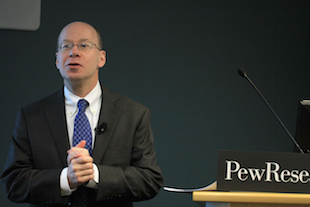
Alan Cooperman: Hello, everybody. Welcome. Thank you for coming. I’m Alan Cooperman. I’m the director of religion research here at the Pew Research Center. Thank you all very much for being here.
As most of you know, the Pew Research Center is a non-advocacy, nonpartisan think tank – I’m sorry, fact tank, not think tank – that seeks to inform the public about issues, attitudes and trends shaping the United States and the world. We conduct public opinion polling, demographic research, media content analysis and other kinds of empirical social science research, but we do not take positions on public policy issues or engage in policy debates. This event is part of an occasional series of discussions in which we bring religious leaders, political leaders, government officials, journalists and other experts together to talk about the implications of our work.
Please be aware that today’s session is on the record. We do have some journalists here. We’re also webcasting the event live and we’ll be posting a transcript of the event on our website. You’re welcome to share anything about today’s session on social media if you like.
I think, as you know, earlier this month, we released a major report on the future of world religions. The report explores projected changes in the size and geographic distribution and percentage share of eight major religious groups – Christians, Muslims, Hindus, Buddhists, Jews, the unaffiliated, folk religions as an umbrella category and all other religions as a final umbrella category.
I think, writ large, we often realize that the most exciting advances in social science, as in the hard sciences, come when we are able to take techniques from one field and apply them to another field. That’s what we’ve tried to do here. We’re using demographic techniques and concepts, particularly cutting-edge techniques in population modeling, and applying them to the study of religion and religious change around the world.
I think it’s only a slight exaggeration to say that this has never been done before. It has, to some extent, been done with some religious groups in some parts of the world, but never before has anybody attempted to try to take data on the age structure of populations and their gender structure, fertility, mortality, migration and religious switching, put them all together and make scientific projections about the growth trajectories of major religious groups all across the world.
We’ve been working on this for nearly six years, a little longer than I would’ve liked, but we did release the report earlier this month with an interactive website where you can explore the data by religion or by country or by region of the world. We will have bound copies of the report in a couple of weeks, so I’m sorry we don’t have them for you today, but if you leave your business card or sign on a sheet at the desk where you signed in today, we will be sure to send you a copy of the report.
We were fortunate to have funding for this from the Pew Charitable Trusts, of which the Pew Research Center is a subsidiary, and the John Templeton Foundation. As a non-advocacy organization, we say virtually nothing in the report about the geopolitical, economic or social implications of these projections, and so we’ve brought you here today to have what I hope will be a lively and thought-provoking discussion of those issues. We’ll start with an overview of the report’s findings from our lead researcher, Conrad Hackett. We also have two outstanding scholars here to discuss the findings – Dr. Jack Goldstone, professor of public policy at George Mason University and a fellow at the Woodrow Wilson Center; and Dr. David Voas, professor of population studies at the University of Essex in the UK, where he is deputy director of the Institute for Social and Economic Research. We’ll also have Q&A, and all three experts will be happy to answer your questions.
Let me introduce the demographer whose leadership and commitment over the past several years made these projections possible. Conrad Hackett is an expert on international religious demography and how religion influences population growth. Before coming to the Pew Research Center, he was at the University of Texas at Austin’s Population Research Center. He earned his doctorate from Princeton University’s Department of Sociology and Office of Population Research.
One request. Please hold your questions and comments for now, but do feel free to get up and get more food and more coffee. Now, let’s get started. Conrad?
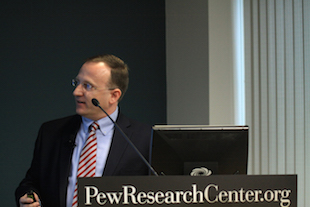
Conrad Hackett: Thank you very much, Alan. It’s a delight to be with you here today and to talk about this report that we have worked on so carefully for so long.
This report is a continuation in a series of reports that we put out over this six-year period, describing the size, the geographic distribution and the characteristics of major religious groups around the world. I’m going to talk today about how we’ve measured these groups and projected their future, some of the general demographics shaping the world’s population in the decades ahead, characteristics of religious groups and then, finally, what this all means for the future that we expect in the decades ahead.
In our work, we began by collecting data from all the world’s censuses that have religion data. Nearly half of them do, although the United States does not. Gathering data from large-scale demographic surveys, particularly the demographic and health surveys that take place in developing countries, and then other kinds of surveys, including many carried out by the Pew Research Center all around the world. Altogether, we drew on over 2,500 sources from every country in the world.
Looking at those sources, we carefully produced what we considered to be the best estimate of each country’s religious composition using the eight categories that Alan mentioned, and this is the pie chart of the world’s religious composition as of the year 2010. Christians are the largest religious group in the world, followed by Muslims, and then the unaffiliated, Hindus, Buddhists, folk religionists, members of the inclusive other religion category, and Jews are the smallest of the eight religious groups that we consider.
We gathered data on key demographic characteristics of each of these eight groups. First of all, we looked at 40 age-sex cohorts, such as men who are 14 to 19, or women who are 40 to 44, and by each of those groups produced a composition for that cohort. We measured the fertility of each major religious group in every country, and also looked at the timing of childbirth and how that differs in various countries.
We looked at migration patterns. This took a lot of work and has subtle effects in the report. It doesn’t change the world’s overall composition because people still migrate from one part of the world to another, but in individual countries, it can have a significant impact as, for example, a lot of Christians from the Philippines move to the Gulf Cooperation Council countries, increasing the Christian share there. We looked, finally, at patterns of religious switching, the difference between what religions people say they grew up in and what religion they now have as adults. This measure comes from surveys in the general population. Censuses, unfortunately, do not measure religious switching.
Taking all of these various types of data, we used a demographic technique called multistate cohort component projections. We described this in the report. I won’t go into all the details, but I want you to know that we took extreme care to pay attention and use the best tools of social science to project cohort by cohort using all of these characteristics the expected religious future in every country of the world for each of these groups.
There are some key overall global demographics that are shaping the future of each religious group around the world. One pattern is that globally, fertility is declining. Back in 1950, the average woman, according to United Nations, had about five children. Now, the global average is about 2.5 and the UN expects, and we rely on their expectation, that by the year 2050, the average woman in the world will have about 2.1 children.
At the same time, life expectancy is increasing, so while the average woman is giving birth to fewer children, those children are living longer. They’re more likely to survive into adulthood and in adulthood to survive to older age than used to be the case.
[sub-Saharan]
In this chart, I’m showing here the areas in orange are those that are expected to grow, and that the darker the orange shade, the more growth. The blue shade indicates population decline. In Russia, in China, in many parts of Eastern Europe, we actually expect there will be fewer people alive in the year 2050 than live there today. Those religions heavily concentrated in the orange zones of this map have demographic advantage and those in the light blue and blue shades have more limited potential in terms of the expected overall size of the population in those countries.
What are the characteristics of religious groups today? One of the great things about this report is that we’re not just telling a story about what the world is expected to be like in the future but shedding light on the world that we already live in. As of 2010, Muslims are the group that has the largest share of their population that’s under 15. Over a third of Muslims, 34%, are under 15, compared to 27% of the world’s population and only about one-in-five Buddhists and the people who are in the unaffiliated category – atheists, agnostics and those who claim no religion – are under 15. What this means is that the Muslim population has more people who are going to grow into their childbearing years in the years to come than any other religious group.
This slide shows the current total fertility rate for various groups. Once again, Muslims are at the top of the chart. Muslim women have 3.1 children compared to a global average of 2.5 children. Christians have 2.7, so they’re the other group that’s having above-average number of children right now, followed by Hindus who are close to world average at 2.4 children per woman. Jews are also quite high at 2.3, and this is largely a result of high fertility in Israel. The folk religion category, other religion category, and unaffiliated category and Buddhists are all below two children per woman, so that’s by itself not enough to sustain a population in the long term.

As we released the report, some people said, “Well, you can’t just assume that the fertility rates that exist today are going to continue forever in the future.” In fact, we don’t. We rely on the United Nations’ trajectories for fertility in each country and then we measure the difference. In Nigeria, for example, Muslims have more children than Christians, so even as we anticipate that the number of children born of the average woman in Nigeria will decline, we expect that the relative difference between Muslims and Christians will persist while slowly converging over time, due to our expectation that educational differences between Muslim and Christian women in each country will slowly attenuate.
Another characteristic that we take into account is migration patterns and we have charts like this Christian migration chart for each religious group in the report. There’s a lot of circles here, which indicate that Christians are on the move around the world. The largest circle indicates a large movement of Christians from Latin America to North America. There’s also a considerable movement of Christians from Asia-Pacific to the Middle East-North Africa, largely migrant labor. This is consequential, as I mentioned, for a number of countries around the world, but it doesn’t make a huge impact because most people stay in the country where they were born, so it matters in the United States, we’re the largest recipient of migrants around the world. It matters in Europe. It matters in the Gulf countries, but its effect overall is subtle.
We take into account religious switching. For religious switching, the biggest story is about switching between people who grew up Christian and people who now identify as unaffiliated. There is movement in and out of all of our religious categories but in North America, in Europe, in Australia, New Zealand, we see there is considerable movement of people who say they grew up Christian and now they identify as unaffiliated. So we take the rates observed recently in surveys and we carry forward those rates in the future. Consequently, we expect that there will be a sizeable movement of people continuing into the unaffiliated category for that reason. This is the demographic. This is the advantage that the unaffiliated population has in our survey that they have net benefit from religious switching.
When we put all these factors together, what do they mean for the future of the world’s religious landscape? Perhaps there’s no surprise, considering what I just told you, that we project Muslims are going to grow faster than any other religious group. We project a 73% increase from the size of the population in 2010 to 2050. That’s double the 35% overall growth expected in the world’s population. Christians and Hindus are expected to roughly keep pace with global population growth. Jews, folk religions, the unaffiliated, other religions and Buddhists are not expected to keep pace with global population growth.
Currently, Christians have a fairly sizable numerical advantage over Muslims in terms of the size of their population. That’s going to shrink in the decades ahead. As Christians are expected to maintain roughly 31% share of the world’s population, Muslims are expected to increase from 23% in 2010 to roughly 30% of the world’s population in 2050. While our report ends at 2050, we knew that people might be curious, “Well, what happens if you extend these lines a little bit further?” Maintaining all of the assumptions in our model, if we go out to the end of this century, we project that by the year 2070, there will be an equal share of Christians and Muslims in the global population and that by the year 2100, Muslims would enjoy about a 1 percentage point advantage over Christians in the global population size.
But one thing you’ll notice here is that the rate of growth attenuates that Christians and Muslims actually grow over the course of the century. The reason for that is the high fertility in Africa. While we anticipate that fertility will continue to decline in Africa, we expect that in the latter part of the century, African fertility will still be higher than fertility in the rest of the world. Most people in Africa identify as Christian or Muslim and that is going to drive the growth of both groups toward the end of the century if the trends in our report continue.
Now, one interesting fact for Christians is that while their share of the global population, we believe, has been pretty stable since 1910 and it’s going to be pretty stable in the next 35 years, there has been a big reshuffling, geographically, in terms of where Christians are centered. We actually have some historical data about where Christians lived back in 1910 and so we use this to compare to the 2010 situation and in 2050.
Back in 1910, two out of three Christians lived in Europe. In 2050, we expect that there will have been a 50-point decline that by 2050, only 16% of the world’s Christians will be in Europe. On the other hand, back in 1910, only about 1% of the world’s Christians lived in Africa and by 2050, roughly four out of every 10 Christians in the world are expected to live in Sub-Saharan Africa.
There has also been a considerable growth of Asia’s Christian population. Latin America increased over the last century and is expected to be fairly stable. North America is expected to experience a slight decline in its share of the Christian population in the years ahead.
Now, one of the stories that was particularly surprising to many people who think about global religious dynamics, is our story about the unaffiliated population. We know that in the United States and in Europe, there have been reports in recent years of an increasing number of people identifying as having no religion, being in the religious “none” category, if you will. We tend to call this category the unaffiliated. And so a lot of people in Europe and in North America, I think, assume that these trends must generalize to the rest of the world. However, what’s not widely recognized is that six out of 10 people in this category live in China and the second largest unaffiliated population is in Japan, and China and Japan both have aging populations with very low fertility. While China is somewhat of a wildcard, we think that if anything in the future, it’s likely that religious affiliation will increase in China rather than decreasing.
Consequently, there’s some demographic hurdles for the unaffiliated population to overcome if it’s to grow in the decades ahead. Most of the growth, as I mentioned, is likely to come through switching and we expect there will be about 100 million person growth in the unaffiliated population, but that will not be enough to keep pace with the global population growth. Consequently, we project the unaffiliated will decline from 16% of the world’s population in 2010 to 13% in 2050.
I mentioned that migration is a dynamic that has important consequences in particular places. One of those stories is about Muslim immigration. Currently in Europe, about 6% of the population is Muslim. We project that in a scenario where there’s no migration in the decades ahead, because of the young population and high fertility of the Muslim population in Europe – and high is relative term. Muslims have about 2.1 children in Europe per woman, which would not be high in many parts of the world but is actually higher than any other major group in Europe. Because of this, Muslims would be expected to increase to 8% of the population in Europe, just based on these demographic characteristics. Factoring in expected continuation of migration patterns, we expect 10% of Europe will be Muslim in 2050.
Similarly, in North America, the Muslim population would grow through demographic forces of aging and fertility alone, but with migration, the population increases more. We project that in the United States, Muslims will become the largest proper religious group after Christians by the year 2050, surpassing the Jewish population.
One of the countries whose projections have attracted a lot of attention is India. In India, the country is expected to remain overwhelmingly Hindu, dropping from about 79% Hindu today to 77% Hindu in 2050. But, during the same time, India is expected to become the most populous country in the world, and the Muslim population is increasing as a share of the country from about 14% in 2010 to about 18% in 2050. With a population projected to be 300 million in 2050, there will be more Muslims in India than in any other country. On the one hand, it will be the most populous Muslim country. On the other hand, Muslims will still be fewer than one-in-five people in the country.
Finally, I just want to show you the slide with results for the U.S. We project that the U.S. will continue to retain a Christian majority in the decades ahead, declining from about three-in-four people identifying as Christian in 2010 to roughly two-in-three in 2050. The unaffiliated share of U.S. population is expected to increase about 10 points from 16% in 2010 taking into account children and adults, to 26% in 2050. As I mentioned, Muslims are expected to be the next-largest religious group after Christians, if you don’t count the unaffiliated as a religious group, surpassing the population of people who are Jewish by religion in the United States.
With that summary of our findings, I’d like to turn now to the discussion of what this means.
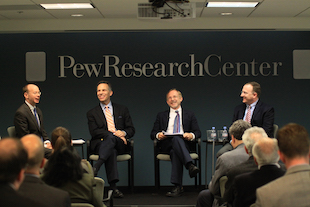
Alan Cooperman: I think we’re going to bring some chairs up and get started. I hope you all are full of questions.
To my immediate left, Dr. Jack Goldstone, professor of public policy and a senior scholar at the Mercatus Center of George Mason University and a fellow at the Woodrow Wilson Center. Dr. Goldstone has a Ph.D. from Harvard. He has worked with USAID, the UK Department for International Development, and the U.S. departments of State and Defense on developing their operations in fragile states. His essay in foreign affairs, you may remember a cover piece – very, very interesting – called the “New Population Bomb: The Four Megatrends That Will Change the World.” It’s a landmark guide to the impact of population change on foreign affairs and geopolitics.
We’re also very fortunate to have Dr. David Voas here. He’s professor of Population Studies at the University of Essex, where he’s deputy director of the Institute for Social and Economic Research. His research focuses on religious change in developed societies. He serves on the executive committee of the European Value study and co-directs British Religion in Numbers, a website on religious statistics. Dr. Voas earned his Ph.D. from the University of Cambridge and he also has degrees from the London School of Economics.
Thank you both very much for being here today. I’ll start. I’ll take a point of privilege with an opening question, if I may, and then please feel free to segue into some general observations.
What do you see as the importance of the decline in the share of the unaffiliated population worldwide? You might think of this in shorthand as the secularizing West versus the rapidly growing rest. Is it a recipe for conflict?
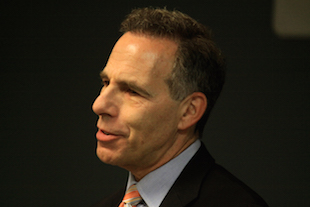
Jack Goldstone: Let me start by saying a lot depends on where you look. Globally, the unaffiliated are shrinking, but in certain countries, they are going to be an increasing portion. One of the striking findings of your report is that I think in France, New Zealand, the unaffiliated become the largest of all groups. Indeed, the unaffiliated make a difference in the dynamics of certain countries. For example, in Europe, the percentage of Muslims grows only modestly to 2050, which on the views of a lot of people who were panicking about Eurabia and Muslims taking over, well, the growth overall in Europe from 6% to 10% is not that startling. But when you add the growth of the unaffiliated, the ratio of Christians to Muslims in Europe shifts from about tne-to-one down to about six-to-one over the course of the next 40 years, with the unaffiliated making up a large chunk of the difference. From that perspective, you’d say, “Well, among the religious, the percentage of Muslims is growing very rapidly indeed.”
Now, overall, I think sociologists jumped the gun in the 19th and early 20th century when we said the growth of modernization will bring with it secularization and a decline in religious belief. That really has not been what we’ve seen. Yes, in certain countries, particularly where the laïcité is pursued vigorously. If you have a government that says religious enthusiasm is dangerous and we’re trying to drive it out of the school system and drive it out of the public’s fear, you get more unaffiliated groups but that’s the exception. In Africa, in America, freedom has led people to be free in choosing their religion and committing to it. In Russia, after the decline of communism, we saw a surge of affiliation with the Orthodox Church. One of the nice things about the report is that honestly, well, if China should loosen its attitude toward enforcing Communism, might there be interruption of religious faith in China as well? I think there probably will be.
I think what we’re seeing in this report is that the idea that religion would fade as the world became more modern is just one of those beliefs that doesn’t correspond anymore to reality. People want religion. They need religion and they will follow religion with the choice of which religion varying with their background in different parts of the world.
Alan Cooperman: David, in the UK, the Christian share of the population has been dropping fairly rapidly and throughout Europe. Do you want to…?
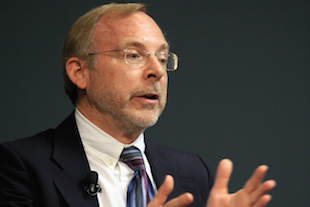
David Voas: Well, then I think that’s true, the West in general. There’s an important distinction that Conrad made between relative changes and absolute changes. What we’re seeing is that in the modern West, the absolute numbers of the unaffiliated are going up. Now, in the West, the relative share of the unaffiliated is also going up, but globally, the demography drives the picture and the difference in population growth is such that the unaffiliated share globally is coming down.
Now, numbers matter, but they’re not the only thing that matters. Ultimately, what’s important is if you like cultural and economic productivity, the big question I think that we need to consider is what’s going to happen to that. It seems to me that the culture of the West is going to become increasingly nonreligious at the same time as the culture of the global South persists in being fairly religious.
Now, there are lots of unanswered questions here and Jack has made some real contributions to describing what happens with population growth country by country and region by region. What’s important with these figures, I think, is to understand the extents to which it is that country-level population growth that’s driving the global distribution of the religious population. That, I think, is what’s going to make the difference.
Alan Cooperman: Can we take some questions? Yes, sir, in the back?
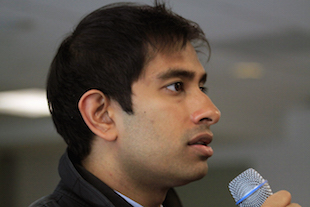
Jay Kansara: Hello. I’m Jay Kansara from the Hindu American Foundation. My question is, is there any consideration given to socioeconomic conditions by which these people will be born into, particularly in sub-Saharan Africa and then South Asia? If they are to be born in subpar socioeconomic conditions and those conditions are improved by government policies, could that potentially reduce the fertility rate in these countries?
Alan Cooperman: Conrad, do you want to address this as a methodological question?
Conrad Hackett: Sure. The United Nations projections for future fertility rates in sub-Saharan Africa do assume that the very high rates in many countries will decline in the coming decades largely because of expectations of improvement in female education levels and other kinds of development, and so that it is baked into the projections. However, if the pace of that change differs, which I believe happens either more quickly or more slowly than the United Nations model projects, then that would be consequential for the results.
Alan Cooperman: Yes, sir?
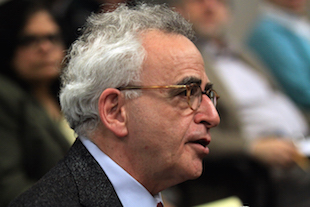
Michael Leigh: Michael Leigh from the German Marshall Fund, where we have a project this year on religion and foreign policy. Comparing Europe with the United States, is it accurate to see a religious, or even increasingly religious, United States compared with, on the whole, a secular and increasingly secular Europe? This is sometimes put forward as one of the major divergences within the transatlantic world. Is that accurate or not?
David Voas: Personally, I don’t think it’s accurate. I’ve recently been engaged myself in some fairly careful studies of the figures for the United States. Although this is controversial, it seems clear to me that secularization is taking a hold in the United States. Now, that’s from a very high level relative to elsewhere in the West. So it’s certainly true that in absolute terms, the United States is much more religious than Europe, Canada, Australia, and New Zealand and so on.
Nevertheless, I think the trend is in the same direction and it’s driven by the same dynamic which is cohort replacement. Less religious younger people are replacing more religious older people in the population. Now, that’s going to take a long time to play out but I would expect a degree of convergence rather than divergence.
Conrad Hackett: Indeed, the last slide that I showed mirrors exactly what David’s describing – this is what we project in our report.
Alan Cooperman: In that 2012 report that we produced at the Pew Research Center called “The Rise of the Nones,” we summed up a lot of the religious trends in the United States. We quoted Professor Mark Chaves of Duke University saying that the debate among sociologists of religion in the United States as to whether religiosity in the U.S. is stable or declining and there’s really no evidence, he argues, or that we can find no empirical evidence that religiosity in the United States is on the rise. I think one could argue between stability and decline.
Yes, sir?
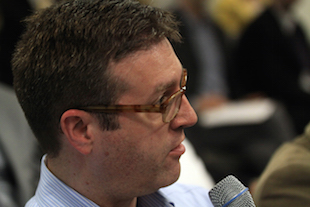
Peyton Craighill: Peyton Craighill, Washington Post. Regarding the phenomenon of religious switching, it’s pretty obvious that this is Christians moving to unaffiliated. That’s the overall phenomenon that we’re seeing, but are there places in the world over the coming decades where you foresee a battle between basically Christians and Muslims switching, and where do you see that? Even if it’s a small number, is this a real potential for great tension?
Alan Cooperman: I’m going to break that into two parts and Conrad, maybe you can address, in the projections, or as we look at the data around the world, do we see any place in which there’s significant switching from Islam to Christianity and vice versa? Then for the implications, we’ll turn to our other panelists.
Conrad Hackett: Well, first of all, we do measure all the patterns of possible switching that emerge in survey data. In the United States, for example, we not only measure people growing up Christian becoming unaffiliated, but people who say they grew up unaffiliated and became Christian. That is a significant phenomenon in the U.S. and also in some European countries.
In terms of switching in and out of Islam, we conducted surveys at the Pew Research Center in many Muslim-majority countries and we found very little report of anybody in those countries saying they have changed their religious identity. Currently, in those countries, countries like Egypt included, that have a significant Christian population, people’s identity just seems very stable. The place where we see some movement out of Islam tends to be in the West when we have people who have migrated from a Muslim-majority country to a place in the West. Like in France, for example, there’s a very good survey that indicates about 90% of people in France who grew up Muslim, many of whom are immigrants, still retain that identity today, but 10% have switched to something else, largely to be unaffiliated or, in some case, to be Christian, but there seems to be much less movement in and out of Islam than is the case for Christianity.
Alan Cooperman: David or Jack, would you like to comment on the implications?
Jack Goldstone: Well, the main implication is that the Muslim population is going to grow much more rapidly than the others. The Christians demographically would be growing apace and, even in the United States, the more fundamentalist Christian faiths have higher fertility than the unaffiliated, but the fact that tens of millions of people are projected to leave Christianity and become unaffiliated is keeping the growth in Christianity significantly lower, especially in the U.S. and Europe, than it would be.
If there’s conflict, one of the things that this suggests is there may be political conflict not only between Christians and Muslims, which we do see in a number of places like Nigeria, but you may see political issues that pit more committed Christians and Muslims on the side of religion against the unaffiliated who want a secularization of society and suppression of religion in the public sphere. We’ve seen a lot of those conflicts in Europe and the U.S. and I think those will continue.
Alan Cooperman: Dr. Mandaville?
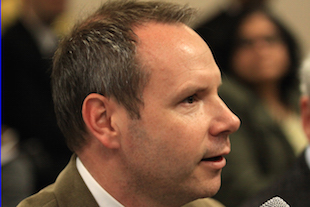
Peter Mandaville: Good morning. Peter Mandaville from the State Department’s Office of Religion and Global Affairs. One geopolitical category that has received increased attention of late is the one often styled as emerging powers or emerging markets, and observers differ in their characterization of who falls into that category. We have a standard Brazil, Russia, India, China story. My colleague Jack Goldstone also urges us to focus on Turkey, Indonesia and Mexico. I’m wondering in terms of religious demography, is there any particular story or trend that can be told about the religious demography of so-called emerging powers and is there any particular implications that might follow from that? Thank you.
Alan Cooperman: Terrific question. Conrad, you want to take a first stab at what you might see?
[311 million Muslims]
Jack Goldstone: Let me add that one of the things that troubles me about these trends, the larger emerging economies – China, Brazil, India – Brazil is Christian, India is Hindu, kind of a one of a kind. China, a mix of unaffiliated, Buddhist, Confucian. None of those really bring a large emerging Muslim country into the top 10 global economies. Indonesia is the one Muslim country that does that but it is a relatively moderate, somewhat unique, homegrown form of Islam. The more standard Sunni mainstream Islamic countries will represent a very large percentage of the world’s population, but will not have any particularly major economies presenting them in world councils. What has been a historic division between a rich Northern and Western versus poorer Southern Hemisphere may start to acquire an increasingly religious tinge with a lot of large Muslim populations in the lower- and middle-income countries continuing to demand why are we not at the level of economic development as the rest of the world. This could drive a continued degree of conflict between Muslims and others in the global future.
David Voas: If I can just follow up on that point, it seems to me critical, as I was saying earlier, what happens to productivity. The key question is these very large predominantly Muslim countries like Pakistan, Indonesia, Egypt do develop successfully and provide employment and prosperity to their people or fail to do so, in which case the repercussions we felt not just internally but externally.
Alan Cooperman: Mr. Socolovsky?
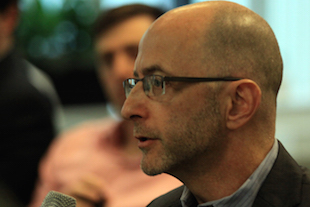
Jerome Socolovsky: Hi. I’m Jerome Socolovsky, religion reporter at the Voice of America. Is there any way of knowing how many people actually lie about their religious identification or at least don’t identify in a straightforward way? We’ve been told here, I believe, that many of the unaffiliated in America at least are spiritual but not religious. They may even identify as a Jesus follower but not as a Christian, or someone in Bangladesh who was born Muslim but doesn’t want to identify for – because of what recently happened to an atheist blogger there. Are there even any implications for this?
Alan Cooperman: Let me also, again, first turn to Conrad on this and I’m going to add a slight fill-up to it as well. Were there places in the world in which where we looked at the available data, census data, for example, we or you took into account the possibility that some groups were underrepresented for these kinds of reasons?
Conrad Hackett: Yes is the answer. I would just say to back up, a lot of people ask about this. Can we really trust what data we’ve gathered, or if we say there are 2.2 billion Christians in the world, people say, “Well, what about real Christians? How many real Christians are there, that believe what Christians should?” Our general guideline is to take people at their word, how ever they self-identify. We don’t have any test of orthodoxy or a practice to differentiate a real this from somebody who just claims to be that. If you are Christian, or if you say you’re Christian, you say you’re Buddhist, that’s what we count you as.
However, there are a number of places where as you indicated that people are not free to identify as such or there might be various reasons why the reports might be biased. In India, for example, there’s a reservation system, sort of like affirmative action in the United States, that provides educational and job quotas for people in scheduled castes or Dalits or untouchables or different names for that group. Consequently, we know from ethnographic work that there are people who practice Christianity and enroll their children in schools and may have a Brahmin teacher who says, “Let’s call your daughter Mary something else while she’s here at school.” Some of these folks, although they practice Christianity, will identify as legally Hindu and the reason for that is that these reservations are only available to people in this category who claim to be Hindu, Sikh or Buddhist by religion. So if they claim they’re Christian or Muslim then they wouldn’t be eligible for that. We met in India with leading religion scholars and demographers and tried to figure out how we could account for this phenomenon and we assume that there’s about a 10% undercount in the Christian count in India census because of this phenomenon. Now, it’s hard to be sure exactly what that is but that’s the decision we made.
Another country where there’s debate about the size of a population is Egypt and Egypt is a little different situation. Their media reports commonly claim that 10% of the population is Christian and the Christian-Muslim divide is a politically contentious one, but there’s been over a century of census data gathered on religion in Egypt. The census data currently shows about 5% of the country as Christian and I’ve reached out to everyone I could to ask, “Are there any reasons that we could have a large-scale undercount so that maybe the share of Egypt Christian population really is 10% of the country?” I haven’t yet found an account that will explain this because the Christians are very proud in Egypt and while there could be some minor underreporting, it seems that that census and survey data that validates it is probably accurate.
This is a long way of saying that we tried to pay very close attention to these dynamics in every country and do the best job we could to account for these various biases, and we describe a lot of this in the methodology of the report, but there’s so much work country-by-country that we didn’t get into all that so I’d be happy to answer any specific questions about particular countries also.
Alan Cooperman: Jack?
Jack Goldstone: I mean I’d like to go on record as praising the effort and care that went into these figures. You would be wise for any demographic projections to immediately put a plus- or minus-10% bracket on any of the numbers because we’re human beings. I have friends whose family migrated from Italy to Argentina. They grew up speaking Italian at home and Spanish in school but when they come to the United States, they can classify as Hispanic because they’re from Latin America. We live in a world that doesn’t capture the complexity of human experience, but to the best that can be done through reasonable efforts at being consistent across countries, I think this report does give us a finer starting point than anything we have.
David Voas: Yes. I would endorse that. Just very quickly, I think there are two aspects to your question. One is whether there was systematic underreporting for essentially political reasons. On that, I think the answer is no, probably not. Maybe in a few places – China, Egypt – that suppression did result in undercounting. The bigger question has to do with the sheer difficulty of measurements in this area, and particularly in the West, what it means to have a religious affiliation, which can range everywhere from “vaguely aware of some heritage” through to “this is the most important thing in my life.”
Alan Cooperman: Great. Rabbi Saperstein?
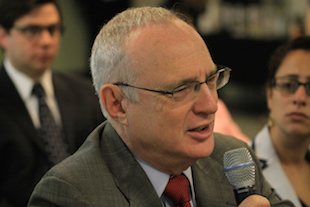
David Saperstein: I’d like to pick up on the census questions that we were just dealing with. If you look at countries relatively comparative to the United States in terms of openness, democratic structures, and you look at the polling data that is done using techniques similar to those in the United States and compare it to the census data, is there any pattern you see that would give you insight into what would happen in the United States if religion were included on the census data? So that’s one and what do you about countries such as let’s say Pakistan which is such an important country for a whole variety of reasons on these issues but hasn’t done a census for quite a while? I don’t know what kind of studies are available. I’m curious in that country what you did to come up with the data.
[Laughter]
Conrad Hackett: You’re absolutely right that Pakistan is a challenge. They haven’t been able to properly conduct a census in recent years. They had a preliminary housing census that suggested a very large number of people in Pakistan, but the United Nations in recent years has actually downwardly revised the number of people they believe live in Pakistan and so consequence of that for our report is – for this question of who currently has more Muslims, is it Pakistan or is it India? Using the United Nations estimates of how many people live in Pakistan now, we believe there are more Muslims in India, but if you use the highest estimates of Pakistan’s population, that would be different. For measuring religious identification within Pakistan, the sources we had available to us included the demographic and health survey-type data, large-scale demographic surveys that is, and then previous census administrations which were also plagued with some difficulties.
To answer the first question you asked, of course, we haven’t ever had a proper census question on religion in the United States. There was, back in 1957, a current population survey, sort of a test question for considering putting religion on the census. I don’t know what would happen, but I know that in the United States, the surveys we ask have a one-step way of asking about religion. We say, “What is your religion?” We often include a series of categories. What’s interesting is that in a number of European countries, there’s a two-step question where they’ll say something like, “Do you have a religion” or “Are you religious and if so, what is your religion? What is your denomination?”
There we see that there’s often a difference, so I believe that European Social Survey in Austria had this kind of a question back in 2002 and they found that 12% of people in – excuse me, 20% of people – in Austria said they had no religion when they were first given this kind of filter question, “Do you have a religion or not?” So people who have a low level of religious commitment, they sort of filter out. On the other hand, the Austrian census which still measured religion in that period, it just basically said, “What is your religion” and by that way of measuring, only 12% of people said they had no religion. So in a place like Europe where there’s a lot of people who have an identity that could go either way depending on how you ask it, it absolutely is consequential whether you have a direct one-step question or not.
Alan Cooperman: Conrad, is it also true that some censuses around the world that ask about religion specify that that particular question is an optional response?
Conrad Hackett: Yes, that’s absolutely right. So there are challenges underway that are going to make this complicated for us in the future — people being given the chance not to answer. The Czech Republic, something like 40% of people didn’t answer the religion question. Also a lot of countries are deciding either to phase away religion questions in the census or, in the UK, for example, thinking, “Maybe we don’t need a census after all,” and so that’s going to pose a challenge for us in the future.
Alan Cooperman: Did you slightly misspeak, Conrad, when you said the difference between Pakistan – and you said India. Did you mean Indonesia in total number? Or you meant India in total number?
Conrad Hackett: Well, it’s pretty clear that as of 2010, Indonesia had the most Muslims. What’s less clear is who is in second place and so we do expect that India will take the No. 1 place in the future, but the challenge – the question I’m raising here – has been who’s in the No. 2 slot.
Alan Cooperman: And do we have general consensus that what a census would find about religion in the United States would depend on exactly the way that census question was worded?
Jack Goldstone: Hugely.
David Voas: Yes, wording makes a huge difference – up to 25 percentage points in some cases. Having said that, we, as you know, have a number of surveys now from Pew, the American Religious Identification Survey, from the General Social Survey, Gallup for that matter, and they all pretty much converged on the distribution of the population. So for the United States, I’m guessing that it wouldn’t be very different if there were questions on the census.
Alan Cooperman: Yes, sir, in the clerical collar.
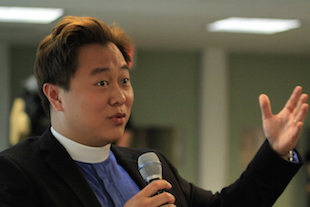
Alistair So: Thank you. Alistair So, the Episcopal Church. I have a question about religious switching that you talked about. You have almost no data about Muslim switching out of their religion or very little data but…
Conrad Hackett: We have data. It’s just that we have very little evidence that a large number have done so.
Alistair So: Sure. So there’s a lot of anecdotal evidence in Turkey. There are people who formally identified as regular Turks that now finding out that they have some Greek or Armenian backgrounds and there’s a lot of switching that way. It seems feasible in that society but has that been documented, other than just the anecdotal evidence, is the first question. And the second one is, I think Professor Goldstone was mentioning about they’re using the French word, a society that promotes laïcité would have more of an unaffiliated population but in a country like a Turkey which is switching from that laïcité secularism model to a more religious model, what are we seeing? Because from all the data you have numbers. I know you don’t want to identify who’s “real this” or “not real that” but is there a way to measure the inclusivity of that society? Is it a kind of a religious society perhaps like in Turkey where religions other than Islam may thrive at the same time, or are we seeing more restrictions as a way to measure that? Thank you.
Conrad Hackett: How about I take the first part of that. In Turkey, I don’t recall that we have any surveys that measured religious switching per se, but Turkey is a country like Russia where it seems that in recent years, there’s a nationalist movement to identify with the largest religious group, the Orthodox Church in Russia, with Islam in Turkey. So if I recall correctly, a decade, decade and a half ago, you might have had 91% or so of people identifying as Muslim in Turkey. Now, the data I think have numbers more like 97%. So that’s the overall direction of change. I’m sure there are individuals who have experienced the movements you describe, but we don’t have particular measures of that and I suspect it probably is not a large-scale phenomenon.
David Voas: Yes. Just to follow up on that, I think again is worth going back to this distinction between the absolute and the relative. In absolute terms, you can have thousands or tens of thousands of people doing something and it looks very striking but that can still be a very, very small percentage of the population.
Alan Cooperman: Yes, sir?
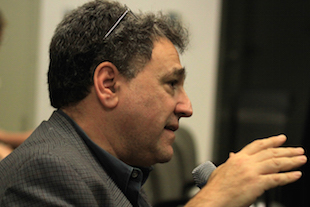
Ron Kampeas: I’m Ron Kampeas from the Jewish Telegraphic Agency. I have technical questions and broader questions coming out of it. When you say that people are switching out of Judaism and they’re switching out in the greater – the degree that they are switching in, are you talking about switching out into unaffiliated as well? Does switching out include unaffiliated? In terms of unaffiliated, I mean that would present to me a demographic problem because in Israel, I gather you’re probably just gathering from population registry where people who would consider themselves atheists would be registered as Jews. Whereas, the United States, you say in the footnote that you’re actually excluding those people and that’s an important difference because I think that Jews would consider themselves those people Jews and maybe those people themselves would consider themselves to be ethnic Jews if not religious Jews.
That’s interesting because you say also in that same footnote that if you take into account that population, you’ve got pretty much by 2050, an even – or you might have by 2050 – an even representation of Jews and Muslims in the American population and in terms of the political importance of Jews in the American and the cultural importance of Jews in the American population, that actually presents a rosier picture for the Jewish community here because if you look at the way that the American Jewish committee surveys Jews, it includes those Jews. It includes unaffiliated Jews and so I just wanted comment on all that. Thanks.
Alan Cooperman: So let me also break that into two parts and first, Conrad, if you would like to say something about the definition of who is a Jew and who belongs to any of the religious groups for the purposes of this study, I could also say something about other studies we’ve done of Jews in the United States and then I’d like to ask a question of our panelists about the implications of the relative increase in the share of Americans who are Muslim and the relative decline in the share of Americans who are Jewish at least by religion. So let’s start with the methodological question.
Conrad Hackett: Sure. So as I recall in Israel, we’re relying on the statistical agency in Israel in terms of current composition and I believe Israel is one of the countries where we do not model switching in the future. In the United States, we’re looking at measures of religious identity and so somebody who would say they are unaffiliated but Jewish otherwise, for our purposes, we just go with that religious identity and Alan’s actually been touring the country and speaking to Jewish groups all over the place so has lots of experience addressing this.
Alan Cooperman: Well, I would just say that of course anybody who understands Jewish populations understands that Jews think of themselves both as a religious group and as a people, an ethnic group. For the purposes of this study, anybody who self identifies as Jewish by religion – that is in answer to a question about their religion – is classified as Jewish. If somebody has, let’s say, a Jewish mother but is a Christian and they answer the question about their religion and saying they’re Christian, they are classified as a Christian even though they have a Jewish mother. Similarly, anybody who answers the question about their religion by saying that they are an atheist, an agnostic or nothing in particular is classified for the purposes of this study as unaffiliated.
If we didn’t do that, we would effectively be double counting somebody who is both Jewish and unaffiliated. The same holds for any other group. There are many people in the United States who were raised in one religious tradition. And this includes Muslims, this includes Hindus, this includes Christians and who today do not identify with that group. Nonetheless, they may still have some association with that group and if you were to prod them in a certain way, they would tell you and so you could – someone who let’s say is of Pakistani extraction living in the United States was raised as a Muslim but is today unaffiliated, if they answer a religion question by saying they’re unaffiliated, we would, for the purposes of this study, count them as unaffiliated, not as a Muslim. There are no ethnic Muslims in this study and no ethnic Jews. There are only religious groups by religious identification and that’s parallel for all the groups. At least in theory, that’s the theoretical what we’ve tried to apply. Individual censuses and data sources around the world may ask the question somewhat differently. We have in other studies attempted to count numbers of, if you will, ethnic or cultural or secular Jews both in the United States and in the future we’ll have that in Israel as well.
On the implication, so in our study, we project that by 2050, the number of people who identify with the Muslim faith, shall we say, in the United States, will be higher than the number of people who, in answer to a question, “What is your religion,” will say they are Jewish. We’re going to leave aside to people who have Jewish blood, if you will, but don’t any longer identify with the Jewish faith. What are the political implications of that?
Jack Goldstone: I actually don’t think it will matter very much. The reason is that among the Jewish community in the United States, the most salient political issue is support for Israel. While not all American Jews share that, those who get most politically engaged, generally do so on that issue. Among Muslims in America, you have Muslims from Somalia, India, Pakistan, the Middle East, North Africa, other parts of Africa, other parts of Asia and they all have a different agenda. They are not all hostile to Israel. They are not all committed to a particular outcome in their home countries and I think it’s very unlikely that the Muslim community in the U.S., even if it reaches 2% to 3%, is going to be strongly organized to pursue any particular united goal, whereas the Israeli community has been unusually well-organized for that and I think will stay that way in the future.
David Voas: Yes. I think my answer to this one, and is certainly consistent with Jack’s, is that very much like the convergence of the Christian and Muslim graphs for the global population, the convergence of the Muslim and Jewish graphs for the American population is fascinating, but, ultimately, probably does not matter very much. I mean it’s a bit like regarding these two things as football teams and they’re not actually football teams. These are groups that are extraordinarily diverse and they represent a multiplicity of forms of identification, belief and practice.
So when we come down to the actual implications of it, again, I think it’s not just numbers that matter. Soft power is very important and the question is: Who’s better integrated into the social and cultural and economic elites or mainstream? Muslims so far have tended to be outsiders. They’re typically far more advantaged in the United States than elsewhere in the West, but, nevertheless, there’s a lot ground that American Muslims will have to make up to have the sort of integration into the mainstream and influence on policy and culture that the American Jewish population has.
Alan Cooperman: Yes, sir?
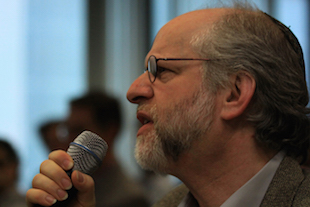
Robert Eisen: Hi, I’m Robert Eisen. I’m professor of religion at George Washington University, also professor of Jewish Studies and also chairman of the Religion Department at GW. It seems to me that the most important – one of the most important – religious divisions in the world now is one that hasn’t been talked about yet and that is between Shiite Muslims and Sunni Muslims. We Americans just – we see both and we just see Muslims but it seems to me that this division may be the most significant religious division in the world today and is likely to continue to be an important division.
I’m involved in a project in which we bring Saudi scholars to GW, scholars of religion, to talk to our faculty about religion and it ends up being an academic and religious dialogue. It’s very interesting. We’ve done a series of these and we had one recently and it’s quite clear that those Saudis actually have a lot more trouble with my Shiite colleagues at GW, whom they don’t really regard as real Muslims, than they do with me as a Jew. I mean this division is an extremely important one and all you have to do is read the newspapers and see that this is how the world is. A lot of really just violence in the world is going in this direction so I’m just wondering whether Pew and others here are thinking about this and whether – and it seems to me that if you’re going to include religious groupings here, you have to think of this particular division.
Alan Cooperman: So let me ask Conrad again first to address, do we have separate projections for Sunni and Shia and if so, why not? Was that just an oversight? What about other subgroups? Why not, for example, Catholics versus Protestants versus Orthodox Christians? Why not Orthodox Jews versus Reform or hiloni in Israel?
Conrad Hackett: Yes. Well, we absolutely agree that this is a very important story and we would love to be able to go into depth on all of these subgroups, including atheists, too, as a subgroup of the unaffiliated population, and, unfortunately, we don’t consistently have the kind of demographic data around the world necessary to do that. We could do it for particular countries and fortunately at the Pew Research Center, we’ve done a global survey of Islam and so we’ve tried to describe differences between Sunnis and Shias and attitudes between the groups in many countries around the world. That’s true for various groups, we’ve done surveys where we can dig into these differences and talk about such salient matters. But it’s been a tremendous amount of work to tell the story we’re able to tell just for these eight groups and perhaps in the future, we’ll be able to dig into some subgroups in particular places in terms of projections, but this is at least a starting point.
Jack Goldstone: The point you make about religious conflict, it’s an old truth that religions tend to review – they view heretics as more dangerous than outsiders because heretics call your orthodoxy into question. Outsiders can often be dismissed as ignorant or foolish and just not part of our group. So even in the Ottoman Empire, which was famous for its toleration for Greek and Armenian Christians and Jews, there were severe brutal religious persecutions every few decades. They were aimed at Shia minorities in the Ottoman Empire.
So we find this today, it’s not surprising in Christianity when the reformation struck, the big wars pitted Catholics against the Protestant heretics. I don’t think that’s going to change but I do think we need to pay attention to another difference and that is within religions between those who view religion as an individual right of exercise of conscience and those who view the rights of the religious community as dominant over the individual. It was mentioned by someone in Pakistan the community has the right in many people’s eyes to severely punish or even execute people who speak out and blaspheme against the principles of Islam. That type of view is increasingly widespread and I think aside from religious versus unaffiliated, within every religion, the kind of extreme fundamentalist communitarian view against the more relaxed, tolerant individual view is a conflict that is coming into relief.
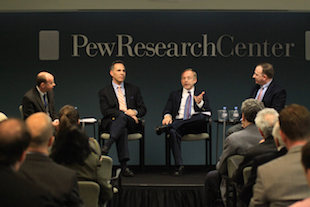
David Voas: This is very consistent with what I was just saying about these big categories, Christian, Muslim, so on, being simply labels for great diversity of kinds of belonging and belief and practice, but I think it’s a very important point because we’re aware of the complexity of the affiliations with which we’re most familiar ourselves. So we recognize how complex Christian and Jewish identity is and the levels of religiosity that that might correspond to or not but we tend to think of other groups as being somehow monolithic and perhaps slightly daunting for those reasons, whereas, in fact, you have the same kind of diversity and indeed internal tensions not to say hostility within those. Indonesian Muslims are not at all like Pakistani Muslims who are not at all like Egyptian or Gulf Muslims and they, as Jack was saying, can be real problems internally for those groups. So those are things very well worth bearing in mind.
Jack Goldstone: I would add that if you look for a country where religious identity and demography are crucial in a microcosm, you wouldn’t have to look no further than Israel, where the difference between Orthodox Jews, secular Jews, Muslim citizens of Israel and Muslims with citizenship claims that are contested are all in conflict with each other and where the demography is driving the country away from the dominance of European secular Jews toward other groups.
Alan Cooperman: I’ll just note, factually two pieces of information. We do have, in a report on Muslim populations worldwide a few years ago, in an appendix, we did make estimates in ranges of the share of Sunni and Shia in quite a number of countries. Also in, as Conrad alluded, in our global survey of Islam, in which we’ve surveyed Muslim populations in about 40 countries, we have asked whether people identify as Sunni or Shia and we’ve also asked about attitudes, “Do Sunnis consider Shia to be Muslims? Do Shia consider Sunnis to be Muslims?” and so on. Just one thing that’s very interesting is that in quite a few countries with large Muslim populations, very large segments of the population do not identify as either Sunni or Shia. They identify as just Muslim and that’s an important factor, also sometimes not widely regarded. Peter Mandaville who’s here is I think one of the world’s experts on these subjects. Anyway, there are plenty of people to talk with.
Please, more questions. This is great. Yes, sir?
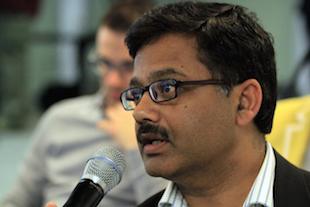
Lalit Jha: Hi, this is Lalit Jha from PTI Press Trust of India. I have a follow-up question on the remarks made by you previously. Can you elaborate further on the implications, on the predictions that you have made for India? You said they have large implications, and, secondly, have you done any predictions for other two countries in South Asia, Pakistan and Bangladesh, what the population, religious demographic composition would be by 2050?
Alan Cooperman: Conrad?
Conrad Hackett: I don’t remember off the top of my head the numbers for Bangladesh and Pakistan but we do have in the back of our report the numbers for every country of the world. So we have that and we also have a website Alan mentioned, globalreligiousfutures.org, where you can dig into depth and see what are the fertility rates for religious groups in those countries and age structure by religious group. In terms of implications in India, it’s interesting that in the weeks since our report has come out, it’s attracted a lot of interest in the press and political leaders have made various remarks, in some cases saying, “Well, if Muslims are overtaking – or growing as a share of the population and India’s going to have the largest Muslim population, maybe Hindus better find a way to increase their numbers.” Some commentators in India have said, “Well, looking at the whole report, Pew Research Center is actually saying Hindus are going to retain an overwhelming majority of India’s population” and so maybe the response should take that into account but of course, religious identity is very politically contentious in India. So the various parties have different reactions to this and it’s probably not for me to say what that means, but I just think it’s helpful to keep in context that India’s going to have both still tremendously large Hindu population and this very significant Muslim minority.
Alan Cooperman: David?
David Voas: I think, and I say this not to flatter you, but I think India is the most interesting country in the world in this respect and let me play a little thought experiment with you. See if this reminds you of anywhere else. So it’s a large country that is practically a continent itself. It gained its independence after a struggle with a colonial power, with Great Britain. It’s extraordinarily diverse in its ethnic population. It’s a great democracy, but its political system often seems a bit dysfunctional. There are extremes of wealth and poverty. Does any of this sound familiar? What I’m suggesting is that India is a bit like the United States with the contrast knob on your computer monitor turned right up so all the colors are bright and a bit glaring and scary. Should we be worried? I’m not sure. I’m actually an optimist about India. I think it’s been a great success, I mean notwithstanding all of the problems, it was of course borne into communal violence in 1947 but nevertheless, it’s held itself together. Despite all the problems, it’s really been a remarkable success story. I think it would be fascinating to see how it develops in the future.
Alan Cooperman: Well said. Cathy, yes? Cathy Grossman.
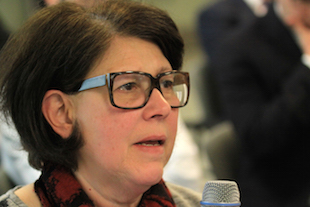
Cathy Grossman: Well, the Pew people will certainly know my question, which is almost always – and this time I’d like to ask the two professors – and that is in looking at this entire report, what would be something that you learn from this report that surprised you? That you just didn’t see it coming until you saw this projection study?
Jack Goldstone: Well, for me the biggest surprise was actually seeing unaffiliated become the largest group in a handful of countries. I had felt that the unaffiliated were being overwhelmed by the growth of religious affiliation everywhere, but clearly that’s not true. Even in America, this report finds a substantial growth in the unaffiliated that frankly had surprised me. I simply had come to take for granted that Christian religious affiliation in the U.S. remains strong and that the unaffiliated were having so few children that they would fade, but, clearly, large numbers of Christians are declaring themselves no longer affiliated with a particular faith or with that faith specifically. So from this perspective, there are really substantial minorities, pluralities of unaffiliated developing in important Western countries, Sweden, France, the U.S. being among the leaders.
David Voas: I think for me what was most interesting is some of the fine detail of the country level of the changing distribution of religious populations. I was basically conscious that what was driving the global picture was relative growth in population terms, country by country, continent-by-continent. So in that respect, I think the big headline stories were no great surprise, but looking at an individual level, it is fascinating to see the change in India, in Nigeria. Even in Europe, I think what interested me, although this is actually the area that – the region that I know best, at how low the projected Muslim population is. Now, of course again that varies a lot country by country in the overall 10% is not by any means evenly distributed. Many Western European countries will have much higher percentages. Eastern Europe often has very few Muslims. But I would urge you if you’re interested to read not just the executive summary but to go and look at some of the detail at the country level because that’s where it really gets interesting.
Alan Cooperman: I think we have time for probably one, or maybe two if they’re fairly quick, additional questions. Professor D’Antonio?
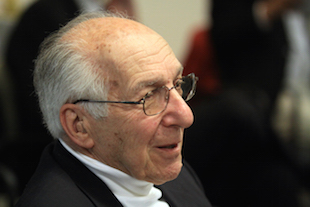
William D’Antonio: Considering the role of women in fertility, I’m astounded that I haven’t heard a word about that variable in anybody’s talk. Maybe I missed the opening one. Did I miss the women’s variable?
Conrad Hackett: Thank you for bringing that up again. I think fertility is so important and it drives so much of the story, particularly for Muslims and ongoing Christian growth, and sometimes when I talk to reporters about this, they said something like, “Well, anything about the future you have to take with a grain of salt. We can know nothing about the future really. Nice try, Pew.” Of course, we want to be modest about what we can say about the future and yet, we know so much about the world today, about the youthfulness of the Muslim population, about their high fertility, about the fertility gap between the unaffiliated and the affiliated. There’s nearly a full child difference between how many children a woman who has an affiliation has and how many children a woman who has no affiliation has.
These differences are – there’s no doubt they’re going to be consequential and so the young Muslim women today who are having three children or more, those children are going to grow up and unless something radical happens, they’re likely to identify as Muslim as adults and a growing share are in Africa. Africa has the lowest life expectancy in the world currently, but it’s expected to experience the largest gains in life expectancy so all these babies who are being born to Christians and Muslims in Africa are going to live longer than their parents and their grandparents did and they’re going to be around in 2050 and reshape the global landscape.
So I would say that one of the major contributions we’ve made is, for the first time ever, to take data from every country in the world and to be able to know what is the best estimate about fertility rates by religion and then to help people by not just presenting that as a fact today but to say, “Well, how will that matter for the future, taking into account everything else?” So now we know this information and thank you for bringing that up because it is so important.
Alan Cooperman: Yes, sir?
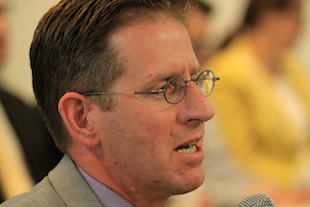
Alan Matney: Just a quick question on China. I’ve heard speculations demographically that China by mid-century could be home to the largest Muslim and Christian population. Obviously, those details don’t flesh out, but I’d be curious what you found on China.
[Phone Ringing]
Professor Fenggang Yang at Purdue University has taken the best data he could find and he believes that Christians are growing rapidly, perhaps 5% to 10% a year in China, and he in January had a piece as published on Slate’s website in which he projected that perhaps, by the year 2050, as many as two out of three people in China may be Christian. That would be remarkable if that should come to pass, but we don’t know. We just simply did not have the data that would allow us to make the same kind of modeling in China that we had in the 70 countries where switching data was available.
Alan Cooperman: But if China did become roughly two-thirds Christian, how would that affect these projections if everything else were held the same?
Conrad Hackett: Thank you, Alan and there’s a sidebar in the report where we delve into this important question. So of the two main headline findings in our report, one is that the unaffiliated are expected to shrink as a share of the population. Well, China has six out of ten unaffiliated people in the world currently. So if most people in China become Christian then that means our story about the unaffiliated is conservative. There’ll be a greater decline in the unaffiliated population if all those Chinese unaffiliated people move to Christianity or some other faith. On the other hand, another of our main findings is that there’s increasing convergence in the size of the Christian and Muslim population. Well, if most people in China become Christian then that would mean Christians would maintain a further numerical advantage over Muslims for some period.
Alan Cooperman: Last observations, gentlemen. David, Jack?
Jack Goldstone: I would simply say that this has not surprised anyone but when we have a situation where the West has been fighting several wars in and against Muslim countries and in which Muslims themselves are more internally in conflict than ever before, if the percentage of the global population that is Muslim is growing very rapidly, that bodes for much more conflict rather than less. So it’s one more reason to think about finding ways to solve or reduce the conflicts both within Muslim countries and societies and between Muslim societies and their neighbors.
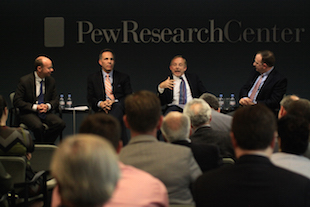
David Voas: I think that’s true. To be a little bit more sanguine, it reminds me slightly of the joke that Bertrand Russell would tell and these are known now as Russell Conjugations. So an example would be, “I am firm. You are obstinate. He’s a pigheaded fool.” I think we do somewhat the same thing with religion. So my religion is of course for the good. Yours does no harm. His religion is downright dangerous. Nobody in this room has, I’m sure, any particular disposition to Islamophobia, but just underline again what we were saying earlier which is that there’s huge amount of diversity within the Muslim world.
I think it’s less the relative growth itself that’s a concern as the absolute growth in countries that are already struggling to provide for the people and to the extent that that development remains stilted or halted then the world does have problems. It has problems of migration that’s not wanted. It has problems of conflict and other sorts of social unrest that will be a real concern but from my point of view, I think Pew has done us an enormous service in bringing together just a mind-bogglingly impressive array of data. I know that Conrad probably knows more about religious statistics overall than any other human being in the world. This report is really the best effort anyone could make at defining what the distribution of the world’s population is likely to be in the decades ahead and we thank you very much for that.
Alan Cooperman: That is extremely kind because I would’ve said that we at the Pew Research Center think of you, Dr. Voas, as the person in the world who knows the most about religious demography, but, in any event, you’re very kind, very modest.
I know we’ve only just scratched the surface. There is a lot more that could be asked and could be said but I’d like to – I did say we’d end at 11:30 and I’d like to get you out of here to the rest of your busy days.
Jack Goldstone, thank you so much. David Voas, thank you so much. Conrad Hackett, great, great work today and on this report. We will again have copies of the report, printed copies available. Please leave your names if you would like one. Thank you all very much for coming.